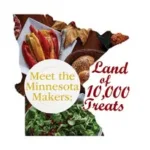|
WHO: |
Woollets |
||
| BUSINESS TYPE: | Wool soil supplement | ||
|
SIGNATURE PRODUCTS: |
Wool pellet made from recycled wool for your houseplants, gardens, and farms |
||
|
WHERE: IN-PERSON: WEBSITE: |
Argyle, Wisconsin Available for in-person pick up for people located near Argyle |
By Michelle M. Sharp, Founder and Content Creator of Meet the Minnesota Makers
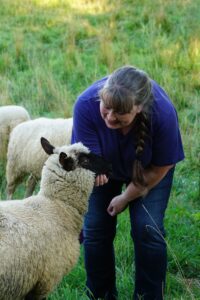 What happens when two friends—one a shepherd frustrated by seeing sheared wool treated as a waste product and the other a teacher and librarian concerned
What happens when two friends—one a shepherd frustrated by seeing sheared wool treated as a waste product and the other a teacher and librarian concerned 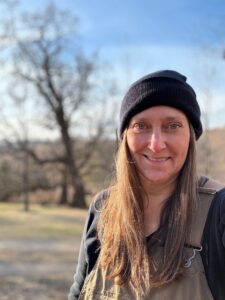 by the decimation of the world’s peat bogs, a natural carbon sink—join forces?
by the decimation of the world’s peat bogs, a natural carbon sink—join forces?
Meet Elaine Becker and Karen Mayhew, the co-founders of Woollets (wool + pellets), two creative problem solvers who converted a waste product into a valued commodity that is a more efficient soil supplement than peat.
Their solution came in the form of a German-invented wool pellet mill that is based on a wood pellet mill. Woollets was born in Argyle, Wisconsin in early 2024. Woollets’ wool pellets replace peat moss as a soil builder, rebuild soil health, and make the long-standing practice of using discard wool as compost more accessible to home gardeners and farmers.
AWARD WINNING INNOVATORS
In its first year in operation, Woollets purchased 18,000 pounds of wool from Wisconsin farmers. They won the 2024 Wisconsin Innovation Award for Agriculture for their contribution to their regional economy and the long-range possibilities of their product. Woollets make it financially-sustainable to raise sheep because they provide a real market for their wool for Wisconsin shepherds.
Wool provides nutrients and aerates the soil as plants get established. “It brings me joy knowing that we are doing something great for the environment with our product,” shares Elaine. “Giving people an alternative to using peat allows consumers to leave the peat bogs intact while supporting a more responsible ecological system by using wool.”
Simply put, using woollets closes the ecological loop. “When you put wool back into the soil, you make use of wool’s carbon-capturing properties,” says Elaine. “Not only are producers able to stop harvesting peat, which allows the peat bogs to fulfill their mission as carbon storage, but we can create a new way to capture carbon, eliminate a waste product, feed the soil and feed the plants.”
Karen and Elaine find joy in the process of simply creating the pellets in a corner of Karen’s farm. “There’s a sense of calm when we put on our headphones and get in the zone of shredding and pelleting,” explains Karen. “It’s pretty noisy, so there’s plenty of time to think.”
HOW THE PELLETS ARE MADE
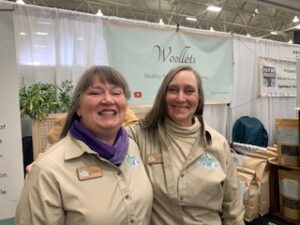 The pellets themselves are one hundred percent wool. Sheared wool direct from a sheep goes into the shredding machine, nicknamed Wilma. Wilma, courtesy of her nine whirling blades of
The pellets themselves are one hundred percent wool. Sheared wool direct from a sheep goes into the shredding machine, nicknamed Wilma. Wilma, courtesy of her nine whirling blades of 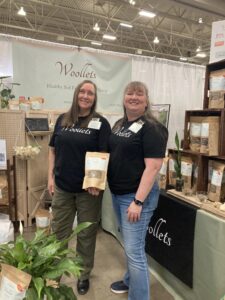 death, shreds the wool into little bits that resemble popcorn kernels. These kernels become pellets courtesy of Betty, the pellet mill. Betty compresses the kernels to create the pellets.
death, shreds the wool into little bits that resemble popcorn kernels. These kernels become pellets courtesy of Betty, the pellet mill. Betty compresses the kernels to create the pellets.
Any seeds on the wool, since sheep often like to wear their food, are neutralized by the heat created by the friction of making the pellet. The lanolin in the wool melts through the friction to hold the pellet together. The pellets harden as they cool, ensuring that they stay intact until applied during planting.
The process is quite labor intensive. Woollets receives raw wool in bags that average six feet in length and a weight of 150-200 pounds. “There’s some entertaining wrestling that goes on as we wrangle the wool,” laughs Karen. “It’s taller than both of us! Sometimes I do wonder how we ended up here as we’re grunting and groaning to load the wool.”
In addition to the weight, the pelleting process is sensitive to fluctuations of humidity in the air and the fleeces themselves —too dry and the pellets fall apart like sand, too wet and the whole thing becomes like mud.
FIELD TESTING
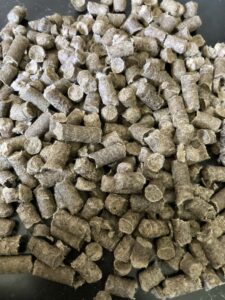
“Its ability to hold moisture is part of the magic of the wool,” states Elaine. “If your soil is dry, the wool pellets release moisture back to your plants. If the soil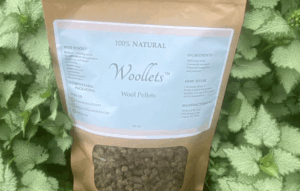 is too wet with the inundation of too much rainwater, the pellets can pull moisture away from the roots.”
is too wet with the inundation of too much rainwater, the pellets can pull moisture away from the roots.”
Karen marvels at everything the wool pellets can do, “They are moisture balancing. It’s a magical substance that we need to think about using throughout agriculture. It’s for more than just sweaters and socks.”
Woollets conducted side by side trials on indoor and outdoor plants comparing their pellets to peat. “Every single time the wool improved the health of the plant and encouraged its growth more than peat or no additives,” states Karen.
Their experiment with a cactus is especially striking. In one year’s time, a cactus that had three pellets in its pot grew twice as big as the one without pellets. The one with pellets required watering every six weeks thanks to the slow release of the pellets in contrast with four weeks for the one without. “Our product is a dream for anyone who tends to forget to water their house plants!” laughs Karen. 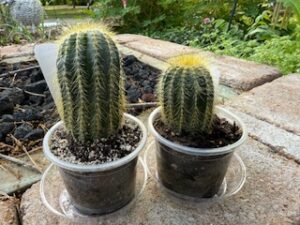
Using Woollets as an additive feeds the soil instead of temporarily supplementing it, enriching the contribution of the microorganisms that make soil healthy. They also help the soil by providing natural aeration. When the pellets expand as they absorb water in the ground, they create an air pocket. These pockets provide the roots with more room to grow.
Elaine and Karen have been friends since their adult children were young and they used to meet to walk together. Their current plan is to retire from their current full-time jobs—Karen works for the United States Postal Service and Elaine is an elementary school librarian and STEM teacher—to fully dedicate themselves to growing Woollets.
GROWING WITH RBIL
Woollets is a member of the 2025 cohort of the Rural Business Innovation Lab. RBIL is a cohort-based, entrepreneurial program that reverses the narrative of rural decline. Each cohort builds a peer network dense with ideas, expertise, and resources that help rural small businesses start and scale their work within their communities. Working in both Minnesota and Wisconsin, RBIL supports rural businesses in their growth to become sustainable drivers of economic health.
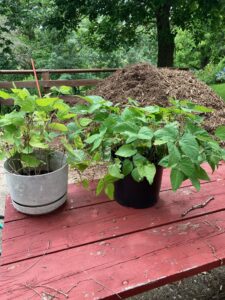
Woollets experiment–the plant on the right had woollets incorporated into the soil. The plant on the left did not…
Woollets applied to RBIL’s program with the goal of finding “boots on the ground” help. “We have a vision of becoming a LEED-certified business and maintaining one hundred percent satisfaction among our customers,” shares Elaine. “Being new entrepreneurs, we were looking for guidance about how to get there.”
RBIL provides templates, one-on-one weekly meetings to discuss issues and goals, and provides access to specialists in different areas to provide all the support that a start up needs. Only a few months into the program, Elaine and Karen feel confident that they are on their way to achieving their goal. “Applying for RBIL is one of the smartest choices we’ve made for our young business,” states Elaine.
YOUR PLANTS CAN THRIVE TOO
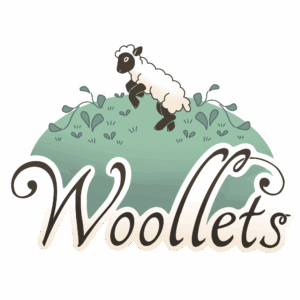 Purchase woollets wool pellets directly from Elaine and Karen at https://www.woollets.net/. Purchase in quantities ranging from 16 ounces to 25 pounds. Wool mulching fleece and shreds are also available.
Purchase woollets wool pellets directly from Elaine and Karen at https://www.woollets.net/. Purchase in quantities ranging from 16 ounces to 25 pounds. Wool mulching fleece and shreds are also available.
Woollets are currently available in ten retail locations across the nation as well as Madison’s online Farmer’s Market https://wisconsinweeklyharvest.com. Wholesale inquiries welcome.
Follow Woollets on Facebook and Instagram to see what’s new with Elaine, Karen or their prized machines Betty and Wilma.
Contact Cameron Payne cameron.payne@cedausa.com at RBIL to learn more about the program. Visit  https://www.cedausa.com/ruralinnovation/ for a program overview.
https://www.cedausa.com/ruralinnovation/ for a program overview.
Follow @ruralbusinessinnovationlab on Instagram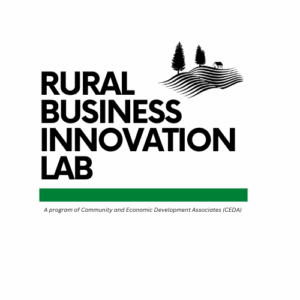
Follow CEDA on Facebook, Instagram, and LinkedIn.
Visit meettheminnesotamakers.com or follow @meettheminnesotamakers on Facebook and Instagram as well as Ambit and LinkedIn to discover the small business owners that make Minnesota an amazing place to be! Meet the Minnesota Makers is a news site that connects you to the local food, farms, artists and artisans that make Minnesota thrive.




